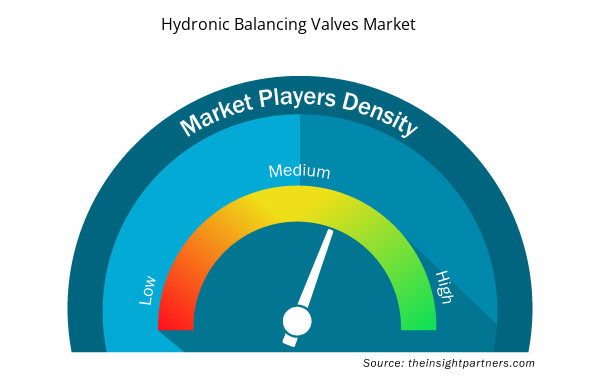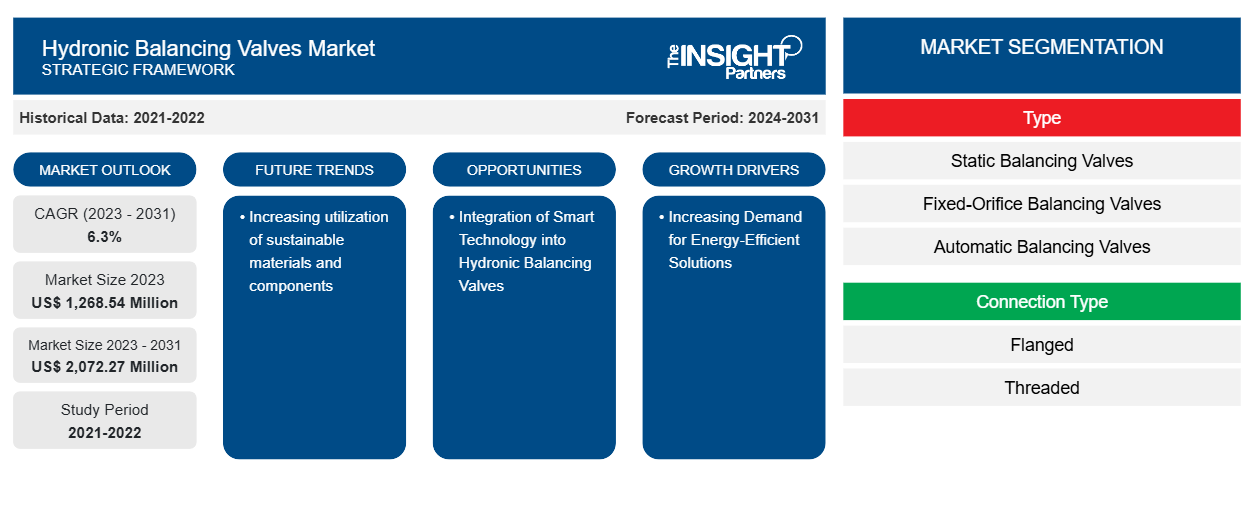预计到 2031 年,水力平衡阀市场规模将从 2023 年的 12.6854 亿美元增至 20.7227 亿美元。预计 2023-2031 年期间市场复合年增长率为 6.3%。在基础设施建设中增加可持续材料和组件的利用可能仍是市场的主要趋势。
水力平衡阀市场分析
美国等发达经济体的人口正在迅速增长,这促进了商业空间数量的增长。根据美国人口普查局 2022 年 12 月提供的城市地区最新名单,美国城市人口在 2010 年至 2020 年间增长了约 6.4%。由于城市化,城市地区变得更加密集,平均人口密度从 2010 年的约 2,343 人上升到 2020 年的约 2,553 人。根据 2020 年人口普查数据,美国西部地区城市化程度最高,约 88.9% 的人口居住在城市地区,其次是东北地区,约 84.0%。中西部和南部地区居住在城市地区的人口比例较低,分别为约 75.8% 和约 74.3%。此外,城市生活水平需要适当、维护良好的住宅和商业建筑基础设施,这推动了对 HVAC 系统的需求。因此,全球城市化进程的加快推动了水力平衡阀的应用,从而推动了市场的增长。
水力平衡阀市场概况
平衡阀是一种节流装置,用于调节流经水暖系统的流体流量。在水暖供暖、通风和空调 ( HVAC ) 系统中,平衡阀可根据当前系统状况,将加热或冷却的水分配到所有终端。水暖平衡阀可确保水暖供暖和制冷系统的最佳性能、高运行效率和较低的运行成本。HVAC 系统中的流体流动不断变化,以适应系统中不断变化的条件。影响供暖和制冷需求的因素包括建筑物占用率和太阳热。正确设计和构造的 HVAC 系统需要在需要的时间和地点提供适当的电力。
散热器、暖通空调系统、热交换器、发电系统、服务器冷却系统和辐射供暖系统等水暖系统应用对水暖平衡阀的需求不断增长,推动了水暖平衡阀市场的发展。此外,全球范围内为减少碳排放而不断加强的能源效率法规也刺激了对水暖平衡阀的需求。此外,住宅和商业建筑活动的激增导致对暖通空调系统的需求不断增加,这反过来又将推动水暖平衡阀市场从 2023 年到 2031 年的增长。
定制此报告以满足您的需求
您可以免费定制任何报告,包括本报告的部分内容、国家级分析、Excel 数据包,以及为初创企业和大学提供优惠和折扣
- 获取此报告的关键市场趋势。这个免费样品将包括数据分析,从市场趋势到估计和预测。
水力平衡阀市场驱动因素和机遇
对节能解决方案的需求不断增加
近年来,消费者对节能电器的偏好日益增长。节能可以降低对发电和输电新基础设施的投资需求,从而减少总体电力需求,带来长期效益。它还有助于公用事业资源组合的多样化,并可以作为对波动性能源采购支出风险的缓冲。为了实现能源效率,许多制造业和商业制造公司都在采购高效暖通空调系统。高效的暖通空调系统比传统系统消耗更少的能源,运行效率更高,从而降低了碳足迹。在水暖系统中,平衡阀有助于将冷水或热水分配到所有终端。暖通空调 (HVAC) 系统在空调和热泵中用于实现节能的应用日益广泛,公共建筑能效标准的日益实施,正在推动各工业和商业部门对暖通空调系统的需求。
将智能技术融入水力平衡阀
物联网设备在住宅、商业和工业领域的普及率在全球范围内不断提高。因此,水力平衡阀制造商正在为客户提供独特的解决方案,并开发可集成到智能暖通空调系统中的智能水力平衡阀。智能水力平衡阀利用互联网的功能,例如实时监控、数据分析功能和自动平衡。通过将这些阀门连接到楼宇管理系统 (BMS),可以实现远程监控,从而显著提高能源效率和系统性能。智能暖通空调系统利用无线技术与附近的智能设备通信并自动调节室内环境。在商业环境中,智能暖通空调系统可以帮助节省能源,同时提供更安静的环境。
水力平衡阀市场报告细分分析
有助于得出水力平衡阀市场分析的关键部分是类型、连接类型、尺寸和应用。
- 根据类型,水力平衡阀市场分为静态平衡阀、固定孔平衡阀、自动平衡阀和压力独立流量控制阀。静态平衡阀部分在 2023 年占据了较大的市场份额。
- 根据尺寸,市场细分为小于 5 英寸、6 英寸至 10 英寸、11 英寸至 20 英寸和 20 英寸以上。2023 年,小于 5 英寸的部分占据了市场主导地位。
- 根据连接类型,市场分为法兰、螺纹和其他。法兰部分在 2023 年占据市场主导地位
- 根据应用,市场分为住宅、商业和工业。住宅领域在 2023 年占据了较大的市场份额。
水力平衡阀市场份额按地区分析
水力平衡阀市场报告的地理范围主要分为五个区域:北美、亚太、欧洲、中东和非洲、南美和中美。
2023 年,亚太地区占据了水力平衡阀市场的主导地位。亚太地区的水力平衡阀市场分为中国、印度、日本、澳大利亚、韩国和亚太地区其他地区。亚太地区的市场增长主要归因于城市化进程加快以及人口增长,这推动了对智能基础设施的需求。此外,政府法规侧重于鼓励应用节能供暖和制冷解决方案,这推动了亚太地区对水力平衡阀的需求。由于城市化的快速发展,该地区的多个房地产项目和众多工业、住宅和商业开发领域的公私投资正在增长。住宅领域对暖通空调服务的需求主要由该地区的新安装推动。由于建筑和开发项目的增加,越南、马来西亚、泰国、印度尼西亚、菲律宾和中国等东南亚国家的空调安装量正在上升,预计这将在预测期内推动亚太地区的水力平衡阀市场的发展。
水力平衡阀市场区域洞察
Insight Partners 的分析师已详细解释了预测期内影响水力平衡阀市场的区域趋势和因素。本节还讨论了北美、欧洲、亚太地区、中东和非洲以及南美和中美洲的水力平衡阀市场细分和地理位置。

- 获取水力平衡阀市场的区域特定数据
水力平衡阀市场报告范围
| 报告属性 | 细节 |
|---|---|
| 2023 年的市场规模 | 12.6854亿美元 |
| 2031 年市场规模 | 20.7227亿美元 |
| 全球复合年增长率(2023 - 2031) | 6.3% |
| 史料 | 2021-2022 |
| 预测期 | 2024-2031 |
| 涵盖的领域 | 按类型
|
| 覆盖地区和国家 | 北美
|
| 市场领导者和主要公司简介 |
|
水力平衡阀市场参与者密度:了解其对业务动态的影响
由于消费者偏好的不断变化、技术进步以及对产品优势的认识不断提高等因素,最终用户需求不断增加,水力平衡阀市场正在快速增长。随着需求的增加,企业正在扩大其产品范围,进行创新以满足消费者需求,并利用新兴趋势,从而进一步推动市场增长。
市场参与者密度是指在特定市场或行业内运营的企业或公司的分布情况。它表明相对于给定市场空间的规模或总市场价值,有多少竞争对手(市场参与者)存在于该市场空间中。
在水力平衡阀市场运营的主要公司有:
- 丹佛斯股份公司
- 海斯流体控制
- Victaulic 公司
- 红白阀门公司
- 欧文托普公司
- 卡莱菲公司 西门子
免责声明:上面列出的公司没有按照任何特定顺序排列。

- 了解水力平衡阀市场主要参与者概况
水力平衡阀市场新闻和最新发展
通过收集一级和二级研究后的定性和定量数据来评估水力平衡阀市场,其中包括重要的公司出版物、协会数据和数据库。水力平衡阀市场的一些发展情况如下:
- 卡莱菲集团宣布完成对 Fratelli Creola Srl 的收购。该公司在当地电镀行业经营了 60 多年,专门从事镀铬和镀镍。两家公司建立了基于相互尊重的长期合作伙伴关系,这种合作关系始于创始人 Francesco Caleffi 和 Lorenzo 和 Quinto Creola,并延续到 Marco Caleffi 和 Marco Creola。(来源:卡莱菲集团,2023 年 7 月新闻稿)
- Mantro、位于绍尔兰的家族企业 Oventrop GmbH & Co. KG 和位于杜塞尔多夫的 LEG Immobilien SE 成立了合资企业 seero,该公司开发用于住宅物业的供暖和可持续性绿色解决方案。seero.Pro 是跨行业三人组在 3 月的 ISH 上宣布的首个数字解决方案。Seero.Pro 自动对每个散热器的供暖系统进行水力平衡。通过需求主导的温度控制,在智能供暖的基础上节省了额外的供暖成本。(来源:Oventrop GmbH & Co. KG,新闻稿,2023 年 4 月)
水力平衡阀市场报告覆盖范围和交付成果
“水力平衡阀市场”规模和预测(2021-2031)”报告对以下领域进行了详细的市场分析:
- 范围内涵盖的所有关键细分市场的全球、区域和国家层面的水力平衡阀市场规模和预测
- 水力平衡阀市场趋势以及市场动态,如驱动因素、限制因素和关键机遇
- 详细的 PEST/波特五力分析和 SWOT 分析
- 水力平衡阀市场分析涵盖主要市场趋势、全球和区域框架、主要参与者、法规和最新市场发展
- 行业格局和竞争分析,涵盖市场集中度、热图分析、知名参与者以及水力平衡阀市场的最新发展
- 详细的公司简介
- 历史分析(2 年)、基准年、预测(7 年)及复合年增长率
- PEST 和 SWOT 分析
- 市场规模价值/数量 - 全球、区域、国家
- 行业和竞争格局
- Excel 数据集



Report Coverage
Revenue forecast, Company Analysis, Industry landscape, Growth factors, and Trends

Segment Covered
This text is related
to segments covered.

Regional Scope
North America, Europe, Asia Pacific, Middle East & Africa, South & Central America

Country Scope
This text is related
to country scope.
常见问题
The penetration of IoT-enabled devices across residential, commercial, and industrial sectors is increasing worldwide. As a result, hydronic balancing valve manufacturers are providing their customers with unique solutions and developing smart hydronic balancing valves that can be integrated into smart HVAC systems.
Regions such as Asia-Pacific, Europe and North America will boost the growth of the hydronic balancing valves market during the forecast period. This growth is owing to the rise in urbanization and industrialization in the regions.
Consumer preference for energy-efficient appliances has been growing in recent times. Energy efficiency can provide long-term benefits by reducing overall electricity demand by lowering the need to invest in new infrastructure for electricity generation and transmission. It also contributes to the diversification of utility resource portfolios and can act as a buffer against the risk of volatile energy procurement expenditure. To attain energy efficiency, many manufacturing industries and commercial manufacturing companies are procuring high-efficiency HVAC systems. An efficient HVAC system utilizes less energy and operates more effectively than conventional systems, lowering the carbon footprint. In hydronic systems, the balancing valves facilitate the distribution of chilled or heated water to all terminals.
Utilization of Sustainable Materials and Components in Public Infrastructure the hydronic balancing valves market growth in the coming years.
Danfoss AG; Hays Fluid Controls; Victaulic Company; Red-White Valve Corp.; Oventrop Corporation; Caleffi SpA Siemens; Frese Group; Johnson Controls, Inc.; American Wheatly; and Xylem are the key market players operating in the global hydronic balancing valves market.
Trends and growth analysis reports related to Manufacturing and Construction : READ MORE..
The List of Companies - Hydronic Balancing Valves Market
- Danfoss AG
- Hays Fluid Controls
- Victaulic Company
- Red-White Valve Corp.
- Oventrop Corporation
- Caleffi SpA Siemens
- Frese Group
- Johnson Controls, Inc.
- American Wheatly
- Xylem
The Insight Partners performs research in 4 major stages: Data Collection & Secondary Research, Primary Research, Data Analysis and Data Triangulation & Final Review.
- Data Collection and Secondary Research:
As a market research and consulting firm operating from a decade, we have published and advised several client across the globe. First step for any study will start with an assessment of currently available data and insights from existing reports. Further, historical and current market information is collected from Investor Presentations, Annual Reports, SEC Filings, etc., and other information related to company’s performance and market positioning are gathered from Paid Databases (Factiva, Hoovers, and Reuters) and various other publications available in public domain.
Several associations trade associates, technical forums, institutes, societies and organization are accessed to gain technical as well as market related insights through their publications such as research papers, blogs and press releases related to the studies are referred to get cues about the market. Further, white papers, journals, magazines, and other news articles published in last 3 years are scrutinized and analyzed to understand the current market trends.
- Primary Research:
The primarily interview analysis comprise of data obtained from industry participants interview and answers to survey questions gathered by in-house primary team.
For primary research, interviews are conducted with industry experts/CEOs/Marketing Managers/VPs/Subject Matter Experts from both demand and supply side to get a 360-degree view of the market. The primary team conducts several interviews based on the complexity of the markets to understand the various market trends and dynamics which makes research more credible and precise.
A typical research interview fulfils the following functions:
- Provides first-hand information on the market size, market trends, growth trends, competitive landscape, and outlook
- Validates and strengthens in-house secondary research findings
- Develops the analysis team’s expertise and market understanding
Primary research involves email interactions and telephone interviews for each market, category, segment, and sub-segment across geographies. The participants who typically take part in such a process include, but are not limited to:
- Industry participants: VPs, business development managers, market intelligence managers and national sales managers
- Outside experts: Valuation experts, research analysts and key opinion leaders specializing in the electronics and semiconductor industry.
Below is the breakup of our primary respondents by company, designation, and region:

Once we receive the confirmation from primary research sources or primary respondents, we finalize the base year market estimation and forecast the data as per the macroeconomic and microeconomic factors assessed during data collection.
- Data Analysis:
Once data is validated through both secondary as well as primary respondents, we finalize the market estimations by hypothesis formulation and factor analysis at regional and country level.
- Macro-Economic Factor Analysis:
We analyse macroeconomic indicators such the gross domestic product (GDP), increase in the demand for goods and services across industries, technological advancement, regional economic growth, governmental policies, the influence of COVID-19, PEST analysis, and other aspects. This analysis aids in setting benchmarks for various nations/regions and approximating market splits. Additionally, the general trend of the aforementioned components aid in determining the market's development possibilities.
- Country Level Data:
Various factors that are especially aligned to the country are taken into account to determine the market size for a certain area and country, including the presence of vendors, such as headquarters and offices, the country's GDP, demand patterns, and industry growth. To comprehend the market dynamics for the nation, a number of growth variables, inhibitors, application areas, and current market trends are researched. The aforementioned elements aid in determining the country's overall market's growth potential.
- Company Profile:
The “Table of Contents” is formulated by listing and analyzing more than 25 - 30 companies operating in the market ecosystem across geographies. However, we profile only 10 companies as a standard practice in our syndicate reports. These 10 companies comprise leading, emerging, and regional players. Nonetheless, our analysis is not restricted to the 10 listed companies, we also analyze other companies present in the market to develop a holistic view and understand the prevailing trends. The “Company Profiles” section in the report covers key facts, business description, products & services, financial information, SWOT analysis, and key developments. The financial information presented is extracted from the annual reports and official documents of the publicly listed companies. Upon collecting the information for the sections of respective companies, we verify them via various primary sources and then compile the data in respective company profiles. The company level information helps us in deriving the base number as well as in forecasting the market size.
- Developing Base Number:
Aggregation of sales statistics (2020-2022) and macro-economic factor, and other secondary and primary research insights are utilized to arrive at base number and related market shares for 2022. The data gaps are identified in this step and relevant market data is analyzed, collected from paid primary interviews or databases. On finalizing the base year market size, forecasts are developed on the basis of macro-economic, industry and market growth factors and company level analysis.
- Data Triangulation and Final Review:
The market findings and base year market size calculations are validated from supply as well as demand side. Demand side validations are based on macro-economic factor analysis and benchmarks for respective regions and countries. In case of supply side validations, revenues of major companies are estimated (in case not available) based on industry benchmark, approximate number of employees, product portfolio, and primary interviews revenues are gathered. Further revenue from target product/service segment is assessed to avoid overshooting of market statistics. In case of heavy deviations between supply and demand side values, all thes steps are repeated to achieve synchronization.
We follow an iterative model, wherein we share our research findings with Subject Matter Experts (SME’s) and Key Opinion Leaders (KOLs) until consensus view of the market is not formulated – this model negates any drastic deviation in the opinions of experts. Only validated and universally acceptable research findings are quoted in our reports.
We have important check points that we use to validate our research findings – which we call – data triangulation, where we validate the information, we generate from secondary sources with primary interviews and then we re-validate with our internal data bases and Subject matter experts. This comprehensive model enables us to deliver high quality, reliable data in shortest possible time.


 获取此报告的免费样本
获取此报告的免费样本